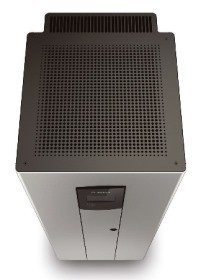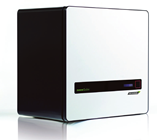Solar hybrid, is, just as the name suggests, a combination of two systems: Grid-connected photovoltaics and battery storage. (Read more about it here.)
For a market that barely existed a couple of years ago, the solar storage scene in Australia is swiftly becoming very crowded. Here's a peek at some of the players pioneering the next wave of household energy use:
Bosch BPT-S 5 Hybrid
 The fridge-sized cabinet, which Bosch talk of as a world-first visionary solution, houses lithium-ion storage cells, using a nickel-cobalt-aluminium technology (NCA).
The fridge-sized cabinet, which Bosch talk of as a world-first visionary solution, houses lithium-ion storage cells, using a nickel-cobalt-aluminium technology (NCA).
It is touted as being able to provide "more than 75 per cent of a household's total consumption - during bright summer months even 100 per cent!" The combination battery bank/inverter/energy managing BPT-S 5 Hybrid is claimed to be maintenance-free for 20 years, and comes in a capacity range from 4.4 to 13.2 kWh.
Aussie Solar TM5000
Carbon Management Solutions Group (CMS), as the company is also known, assert that their evocatively named TM5000 is the "most affordable battery storage system" in Australia, with its particular suite of features. Their Panasonic 12V lead acid batteries are said not to require maintenance and are configured to provide to storage systems in a choice of three capacities: 5kWh, 10kWh and 15kWh.
Akasol NeeoQube
 The Neeoqube is marketed as a "smart lithium-ion energy storage cell for private homes and small systems." Made in Germany, it is said to be up to 98 per cent efficient, with 20 year service life (and a 10 year warranty), that includes 5,000 cycles with 70 per cent Depth of Discharge (DoD).
The Neeoqube is marketed as a "smart lithium-ion energy storage cell for private homes and small systems." Made in Germany, it is said to be up to 98 per cent efficient, with 20 year service life (and a 10 year warranty), that includes 5,000 cycles with 70 per cent Depth of Discharge (DoD).
This service life is suggested as being three to five time higher than conventional lead acid batteries. The NeeoQube can be scaled up with companion units and housed in the NeeoRack.
Leclanché TiBox
Swiss-based Leclanché have been in the battery business for more than a century, but that doesn't mean they can't move with the times. Their TiBox energy storage system uses new lithium-titanate technology to achieve 15,000 charging and discharging cycles. A full charge is possible in an impressively short one hour. One unit weighs about 120kg and three can be connected in parallel, if more power storage is required.
Magellan DCSS
Another acronym burdened product is the DCSS (Direct Current Solar Storage) from Magellan, of Western Australia, which picked up prize money as a Finalist in that state's 2013 Renewable Energy Technology Challenge. The DCSS is available in a range of three capacities, can be built into new PV systems or added to existing arrays, utilising existing inverters. The 22-year-old company reckon their lithium batteries will retain 70 per cent capacity even after 2,000 cycles of 100 per cent discharge.
Redflow ZBM
ZBM stands for Zinc-bromide Battery Module. Known as 'flow' batteries, they "undergo a great deal less electrode damage than lead-acid batteries." Redflow also note that "ZBMs can also utilise full 100 per cent depth of discharge, compared to lead-acid's 40-50 per cent." But before you get too excited, the company also point out that ZBM accomplish this feat by being approximately five times the size and weight of lead-acid batteries. Still, the Brisbane-based business is talking about a "40 per cent cut in the capital cost of energy storage systems" by the end of 2015.
Nedap PowerRouter
 The PowerRouter inverter lays claim to a "unique capability of being able to automatically cut connection to the electricity grid in the event of power outages," although the other units mentioned here have a similar attributes.
The PowerRouter inverter lays claim to a "unique capability of being able to automatically cut connection to the electricity grid in the event of power outages," although the other units mentioned here have a similar attributes.
Through its integrated internet connectivity householders can monitor and control their solar power system from anywhere via an online portal, a feature accessible by smartphones. Hailing from the Netherlands, the PowerRouter sports a modular design that allows users to increase their battery storage capacity at any time.
SMA Sunny Boy Smart Energy
In April of this year, German company Solar Technology AG (SMA) launched their Sunny Boy system, claiming it was "the first wall-mountable, mass-produced PV inverter with an integrated lithium-ion battery." The capacity of the integrated battery is around 2kWh, which the company indicates should allow some households to be about 50 per cent self-sufficient for their home energy needs, and provide independence from rising electricity prices.
ZEN Freedom PowerBank
Zen say their Freedom PowerBank has many operational modes, allowing users to program when they want to charge their Lithium Iron Phosphate batteries and when they want to utilise stored power. The technology in the PowerBank, including Active Battery Balancing which helps overcomes issues of battery degradation, is described as "world-leading," with the units manufactured in South Australia for Australian and international markets.

